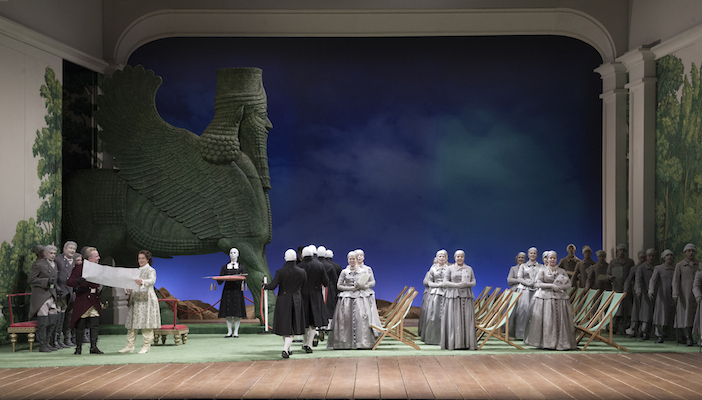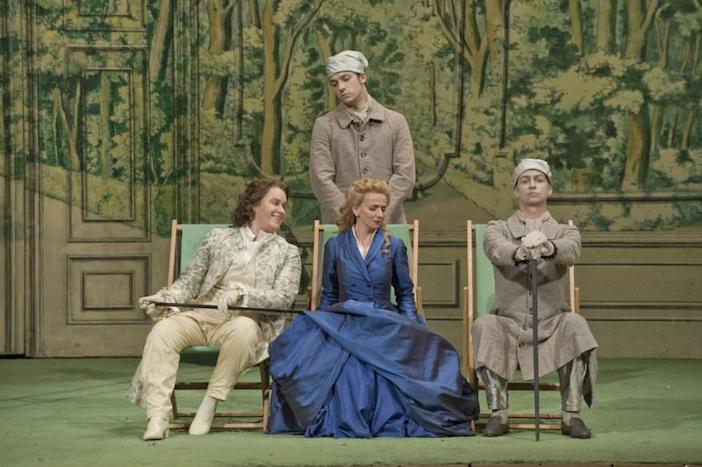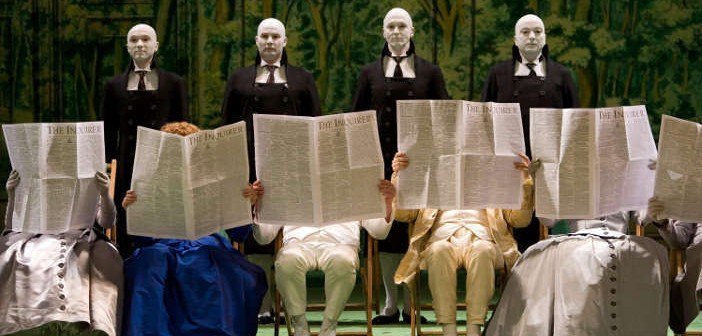There’s a moment in Nicholas Hytner’s production of Xerxes when, at the end of the first act, the green baize curtain, having descended, drops further from the proscenium, exposing its top. For a moment we’re caught unawares, there’s been a technical error, perhaps; until the head of one of the court servants pops up with a pair of shears and impassively begins clipping a few trimmings from what it is meant to be, a hedgerow. It represents a key moment in the comic opera but which, until then, finds much humour lost in building a complicated plot of interwoven love triangles.
There’s an irony here, too. Handel himself described the context of the drama as “so very easy, that it wou’d be troubling to the reader to…explain it”. I think perhaps he’s relying on the power of suggestion. Suffice to say, it is set in the court of medieval Persian ruler, Xerxes, and features a trio of interwoven love stories, between Xerxes, his brother Arsamenes, the daughter of his military commander Romilda, her sister Atalanta, Arsamenes’s servant Elviro and the ruler of a neighbouring kingdom, Amastris, all brought to life with the opera staple of lost letters, misunderstandings and mistaken identity, and a modicum of cross-dressing. As if that were not confusing enough, the two royal brothers, originally played by a castrato and mezzo-soprano respectively, have their roles reversed in modern productions, with Xerxes played here by the indomitable Alice Coote and Arsamenes by counter-tenor Andrew Watts.
The connection to old Iran is tenuous at best, it merely suggests what was a fashion with the orient at the time and Handel himself admits only two references to the past, “the rest is fiction”. Hytner doesn’t take the setting too seriously either, the only touches being a token miniature of Persepolis and a gargantuan Persian centaur statue. Rather, he has set it in another fashion of the age, the pleasure garden, in reference to Xerxes’s fascination for a plane tree – and, again, it providing much opportunity for mirth with courtiers carrying over-sized cacti and suchlike on stage.

The comic energy comes to the fore in Act II, when the comedy of errors and interweaving stories rev up. The credit for much of the humour lies firmly with Hytner’s staging – epitomised by Elviro opening the act disguised intentionally poorly as a female flower seller and catapults the action from lacklustre to energised into the second act. Where the comedy works most particularly is with the baroque orchestration, delicately handled by Michael Hofstetter, punctuated by tooting oboes and parping bassoons and suchlike; while perhaps not as intended to such an extent, these sounds have become more comic to our modern ears. While such light orchestration – uncharacteristically for Handel, there are few chorus set pieces – might not have the texture of Rossini or the emotive weight of Puccini, the simplistic baroque structure, riddled with runs, trills and arpeggios, makes for terrific displays of virtuosity among the performers, with nearly every aria being met with enthusiastic applause.
Much of Handel’s score is solo and recitative until, at the end of Act III, finally, a duet; the denouement between Arsamenes and Romilda charged with energy, like a lovers’ tiff, and delivered in front of the curtain to give all the weight to their voices, it pre-empts the happy ending as all seven voices come together in a beautiful concluding septet. But, for the most part, arias. And what wonderful arias. Ironically, the most notable, Ombra mai fu, is to my mind, the weakest. Far better are Arsamenes’s incredible declaration of his love for Romilda to Xerxes, with Andrew Watts showing such virtuosic range, and Alice Coote, debuting in the title role, spitting all the bile and venom of a spurned lover in the challenging dynamic of her finale.

When it was written, Xerxes was a reaction to the impact of The Beggar’s Opera on the opera seria of the day, a fashion for light ballad over brooding da capo arias and, while not particularly successful at the time, the opera has evolved into a joyful example of the comic oeuvre. It says something of its enduring longevity that Hytner’s production is the oldest in the ENO’s repertoire, now on its sixth outing, first gracing the stage in 1985 for the composer’s tercentenary. It is, too, the most seen production of any Handel opera. As if to mark the tribute, Roubiliac’s statue of Handel, the one in Westminster Abbey of the composer in informal repose, is featured as part of the set – it was, fittingly, originally in Vauxhall Gardens. A fitting tribute indeed.
Xerxes runs for five performances at the Coliseum, on the 20th, 24th, 26th September and the 1st and 3rd October. For more information and tickets, visit the ENO website.
For an insight into the work and the traditional orchestration of the production, read our interview with conductor Michael Hofstetter here.




